ASIAN PHYSICAL CHARACTERISTICS

Chinese Giant in 1870People classified as Asians are physically different in some ways than people of European descent. In almost all cases Asians have straight, black hair and dark eyes. They also tend to have less body hair, less facial hair, flatter faces, smaller noses, wider cheekbones, and "shovel-shaped" incisor teeth (slightly scooped out shape of back side of the front teeth).
Asians are less likely to get some diseases than Westerners and more likely to get others. Many Asians get acne at a later age than Westerners. Fewer Asian men go bald than European men. There also appears to be less Asians with grey hair, but it is not clear whether this is because they get grey hair at a later age or dye their hair. Many Asian children find red and blonde hair and hairy arms and legs to be fascinating.
Northern Asians are generally stockier and have lighter skin and thinner eyes than southern Asians. All skin contains about the same number of melanocytes but the amount of melanin they produce varies. Dark skinned people produce more and light skin people produce less.
Some people think that difference between Asians and Europeans have existed for some times. While holding a cast made of Peking Man in the 1930s, Chinese archeologist Jia Lan told National Geographic, "This skull has some characteristic of modern Chinese people. For instance, the nose bone of Peking man was low and cheeks were flat, as in Asians today."
In China, large eyes, a small nose and petite frame are all regarded as attractive on a woman. Small eyes, large lips, freckles, a flat nose and high cheek bones are all considered unattractive. The ideal beauty has wide, bright eyes and a face "shaped like an upside down goose egg or sunflower seed.” Skin should "not only be pale, but as white as possible" and the body should be slim and "hopefully tall with long legs, small feet and a Pippa Middleton style bottom." [Source: Wikipedia]
Books: “Human Variation, Races, Types and Ethnic Groups” by Stephen Molnar (Prentice Hall, 1992); “The Mismeasure of Man” by Stephen Jay Gould (Norton, 1991); “The Evolution of Racism” by Pat Shipmen (Simon & Schuster, 1994);”Human Biodiversity” by Jonathan Marks of Yale University (Walter Gruyter).
See Separate Articles: BEAUTY IN CHINA: FACE SHAPE, WHITE SKIN AND PAGEANTS factsanddetails.com ; HAIR AND HAIRSTYLES IN CHINA factsanddetails.com ; COSMETICS, TATTOOS AND JEWELRY IN CHINA factsanddetails.com ; COSMETIC SURGERY IN CHINA factsanddetails.com ; FOUR BEAUTIES OF ANCIENT CHINA factsanddetails.com ; CHINESE PHYSICAL CHARACTERISTICS factsanddetails.com ; FOOT BINDING AND SELF-COMBED WOMEN IN CHINA factsanddetails.com
Yellow Skin
Asians are sometimes referred to as having yellow skin. It is not clear where the term comes from especially when one rarely sees an Asian with yellow skin unless they have jaundice. Biologists who deal with such matters classify most Asians as having the same skin color as people living in northern North America.
Some trace its origins to the term “yellow peril”---fear of Oriental hordes overwhelming the West”---which first appeared shortly after Japan defeated China in 1895 and has been attributed to the German Kaiser Wilhelm II but was used before him by the Hungarian General Turr in an assessment of Bismark. Several American newspapers used the term, including Ohio paper “The Sandsuky Register”, which ran a story in June 1895 with the following passage: “The “yellow peril” is more threatening than ever. Japan has made in a few years as much progress as other nations have made in centuries.”
Westerners rarely use the term yellow or yellow skin in association with Asians anymore but sometimes Asians do. Chinese athlete Liu Xiang dedicated the gold medal he won in 110 meter hurdles at the 2004 Summer Olympics to “all the yellow-skinned people” and called his performance a “miracle.” “Because I’m Chinese,” he said, “and have the physiology of the Asian race to me this is a miracle. But because of it I expect more miracles in the future.” In China Liu is nicknamed the “The Yellow Bullet”
Skin Color and Zebrafish
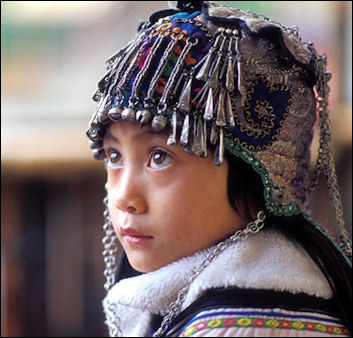
Akha (Hani) girl
The are number of theories that attempt to explain why there are difference in skin color. One theory holds that lighter skin evolved as an adaption to weaker sunlight and the need to extract more sunlight to manufacture Vitamin D. Pale skin makes this easier when the sun’s rays are not particularly strong. But unfortunately , malignant melanoma, the deadliest form of skin cancer, is more common among lighter skin people than darker skinned ones.
In 2005, scientists discovered a tiny mutation in a gene that plays a key role in determining skin color, with Caucasians inheriting a different version than other groups. The gene---named slc245a5---was discovered in a cancer research study using zebrafish, which have the same gene and come in dark and light skin versions. Slc245a is believed to be responsible for between 25 and 38 percent of color variation between Europeans and Africans.
Researchers found that people in Africa and China have one variation of slc245a5 and people of European ancestry have another. The research indicated that the dark version was the original and the light version evolved as humans migrated from Africa into northern areas and is consistent with a theory that lighter skin evolved as an adaption to weaker sunlight.
On the relevance of this finding to race, Gregory Barsh of Stanford University told the Times of London: “The paper indicates how the genetics of skin color variation is quite different from, and not be confused with, the concept of race...One of the most obvious characteristics that distinguishes different humans is nothing more than a simple change in the activity of a protein expressed in pigment cells. Skin color does not equal race period.”
Asian Ears, Eyes and Squatting
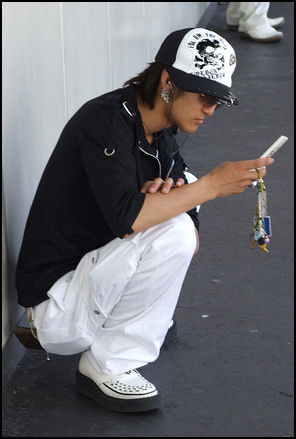
Squatting in Japan
The small webs of skin over the corners of Asian eyes are described by scientists as epicanthic folds. It is not understood why Asians have them and Europeans don't. Most Asians have a dry kind of ear wax that is relatively odorless while Africans and Europeans have wet and sticky ear wax that gives off more smell.
Many Asians also don't have a crease around the top of their eyelid like Westerners do. Some Asian women consider and eylid with a crease to be more beautiful than an eyelid without one and they spend a lot of money for "double slit operatation," to have a crease surgically insisiced into their eyelid. Many Asians also consider round eyes to be more beautiful than almond-shaped eyes. Some Asians prefer glasses with wide, narrow frames that look better with their eyes.
Asians are more comfortable squatting and crouching than Westerners. In many Asian countries people relax and rest for long periods of time in a squatting position that many Westerners find unbearbaly uncomfortable after only a few seconds. Some scientists claim that the squatting position is better for digestion. Many Asians also spend more time sitting on the floor than on chairs and couches, which Westerners prefer. see Japan, China. See Toilets.
Asian Blood and Body Odor
Type B blood is more common among East Asians and Africans than it is among Europeans. Asians generally do not have Rh-negative blood and hospitals do not store it for transfusions. Foreign travelers who have O Rh negative are in big trouble because they can only accept O negative blood, which generally isn't available.
Deodorants are sometimes difficult to find in Asia although they have become more common in recent years, in part through marketing efforts by deodorant makers. Body odor is produced apocrine glands in the armpits and genital area. Men have more and larger apocrine glands than women, and Caucasians and Africans have more and larger glands than Asians.
Red Faces and Mongolia Birth Marks
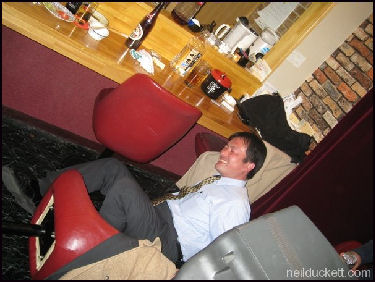
red in the face and
flat on the floor in JapanAbout half of all Asians lack an active enzyme which breaks down acetaldehyde, a toxic chemical derived from ethanol found in most forms of alcohol. As a result, when they drink they often get sick to their stomach or turn red in the face. Most westerners have this enzyme, and consequently they need to drink much more to get drunk or turn red.
Some Asians turn bright red after only a few sips of alcohol. If they continue drinking they often vomit because their bodies reject the alcohol.
Almost all Japanese, Korean, Mongolians, and some Chinese are born with a Mongolian birthmark, a small patch of brown pigment located on their butts or lower back. The mark vary in size and usually disappear within a few years. Indians in North, Central and South Americas also have these marks. Some scientists have suggested that these marks are evidence that these people originated from Asia. "Mongolian spots" are also found in Bushmen (See Below).
Asian Hair
Individual strands of Chinese women’s hair are circular and wider and more resistant to breaking than the oval hairs of Western women. Chinese hair has higher pigment concentrations that makes it glossier and shinier than the hair of Western women and less likely to turn white. Chinese hair is less dense than Western hair with fewer hairs per square centimeter of scalp.
When stripped of its natural pigment, Asian hair has reddish undertones while European hair has yellow-orange undertones. As a result hair dyes for Asian women are made with green that cancels out red while those for European women are made with violet that cancels out the yellow-orange undertones.
More than 150 million Chinese men aged 25 to 35, or about 40 percent of the male population in that age group, suffer from baldness or significant hair loss. Fast-paced living and long periods of stress are blamed for high rates of hair loss.
Many that have hair that goes grey or white prematurely dye it.

double eyelid, the result of a common cosmetic surgery procedure in Asia, See Cosmetic Surgery in China
Asian Skin and White Versus Tanned Skin in Asia
Many Asian women and Asian brides eschew the tanned sporty look and favor the white, frail look. Pale skin is considered beautiful and has traditionally been associated with sophistication and wealth while brown skin traditionally has been a sign of being poor and working outside in the sun. One 38-year-old Hong Kong public relations executive who spent hundreds of dollar a month on face masks, scrubs and whitening creams in the 2000s told Reuters, “I love to be pearly white because that is more beautiful.”
Women often refuse to go out in the summer unless they have an umbrella, a makeshift cape or some other kind of skin protection. One 27-year-old accountant told the Times of London, “I prefer women with light skin. Westerners look healthy with bronzed skin, but Asians look dirty.”
In China Pregnant women have traditionally avoided soy sauce out of concern it might make their baby dark. Skin whitening products are a huge industry. Among the skin whiteners available in China are White Detox by Biotherm, Pure by Dior, Blanc Expert by Lancom and Derma White by Clinique.
The skin of Chinese women is denser and, some say, better quality than the skin of Western women. Chinese women tend to have skin that is free of blemishes and lines for ten years longer than Western women. When the ageing process begins it happens suddenly---with pre-auricular wrinkles developing vertically from the ears and an interocular line crossing horizontally between the eyes and wrinkles appearung on the chin.
In recent years in China dark skin has become a symbol of wealth---a sign that someone has enough money to take a beach vacation in place like Thailand. Honolulu or Spain---with models with sexy tans being featured in fashion magazines . The first tanning salon in Beijing opened in the city’s chic Jiawai Soho area in the mid 2000s. It is patronized mainly by young office ladies, who pay $12 for a ten minute session. Especially among the older generation, dark skin is considered ugly and lower class, and pale white skin is considered beautiful and an expression of sensitivity and cultivation. There is an expression in Japan that white skin can "hide the seven shortcomings of a woman."
In Japan many women walk around with "sun umbrellas" in the summer so they don't get tan. Umbrellas treated with chemicals sell for up to $350, and special attachments can be purchased so women can an attach their umbrellas to their bicycles. Hats, gloves and arm coverings that protect women from the sun are widely available in Japan. White face powder and paint is used by geishas and male Kabuki actors. Cosmetic stores sell a variety of cleansers, moisturizers and foundations aimed at generating bihaku ("beautiful white") skin. Some clinics offer special skin-peeling procedures that whiten the skin through laser treatments and application of ultra-cold liquid nitrogen or acid. In the mid 1990s, young Japanese with natural, bottled and booth tans were common sights. Ganguros ("black faces") was a name given to girls who with orangish, tanned faces, white lipstick, and heavy make-up, platform shoes and outrageous and colorful clothes. See Japanese Women
Milk, Butter, Cheese and Lactase Races
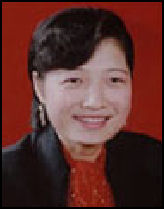
common cosmetic surgery
procedure in Asia, Before Some Asians don't like cheese, butter, milk or other dairy prodcuts and in some cases get physically sick if they eat them. In the old days, many Asian didn't even like their smell. Nineteenth century Japanese described Europeans traders as “bata-kusai” ("stinks of butter").
The aversion for dairy products is partly the result of the fact that many Asians lose lactase, an the enzyme which helps in digestion of milk sugar, as they get older. Groups that don't possess the lactase enzyme are called lactase negative races and those that have it are called lactase positive races.
Almost all mammalian milk contains lactose, a complex sugar that is broken down in the body of most people into simpler sugars like glucose by lactase. If people who lack lactase consume a lot of dairy products, undigested lactose accumulates in their large intestines, ferments, and emits gas. This leads to bloating and diarrhea.
Most adult animals can not tolerate lactose. Over time through evolution humans have developed a tolerance to lactose. Around 8000 years ago most people were lactase negative because they stopped consuming milk when they were weaned form their mothers. Beginning around 4000 B.C. some groups of people began drinking milk from domesticated animals, and later milk became an important food source for people in northern and central Europe, Arabia and parts of West Africa. Natural selection enabled these people to retain the lactase enzyme into adulthood while groups that drink milk lost the enzyme in childhood.
Exposure to American food like pizza and cheeseburgers have made dairy products more palatable to young Asians.
Asians are Getting Taller
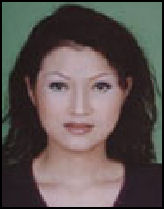
After cosmetic surgery Asians on average are also generally thinner and shorter than Westerners but they are getting taller and fatter. Some believe that at least some of the difference are explained by diet. Japanese today are around three inches taller than Japanese who grew up around World War II. Most scientist attribute the increase to nutritional changes, such as more milk and meat in their diets. Others have proposed more far-fetched theories. One researcher suggested that the switch from sitting on the floor to sitting Western-style in chairs has straightened some Japanese out and made them taller.
In South Korea, 14-year-old children are 4½ inches taller that their counterpart in 1954. According to another study between 1962 and 1996 the average height of women rose from 5-foot-1-inches to 5-foot-3-inches and men rose from 5-foot-5-inches to 5-foot-8-inches.
Most scientist attribute the increase to nutritional changes, such as more milk and meat in their diets and more food period. Since 1954 rice consumption has increased by 40 percent and the caloric intake of the average Korean has increased by a third. Others have proposed more far-fetched theories. One researcher suggested that the switch from sitting on the floor to sitting Western-style chairs has straightened out the backs of Koreans and made them taller.
Breast shape and size, nipple color and shape, the form of a woman's labia and buttocks and the angle of man's erection also varies somewhat between races. by Richard Bernstein, author of Book: “The East, the West, and Sex: A History of Erotic Encounters “ describes the women of Asia as “more plumlike than melonlike of breast, spare rather than full of buttocks and hips.”
Asian women generally have smaller breasts than Western women. Writer Paul Theroux once wrote that the brassier is "probably the most superfluous garment in China." Even so Wonder Bra developed a special product line for slim Asian women. An accountant in Hong Kong told Newsweek, "There's a strong desire to be sexy. People want to marry a good husband, and a push-up bra is part of the package to achieve that goal."
DNA Studies and Asian Traits Found Among Other Groups
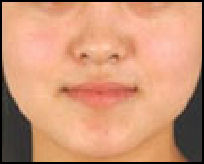
jaw work, common cosmetic surgery
procedure in Asia, before DNA studies have shown that all Asians descend from two common lineages: 1) one more common in southern Asia, particularly among Vietnamese, Malays and New Guineans; and 2) one more common in northern Asia, particularly among Tibetans, Koreans and Siberians.
Khoisians ("bushmen") from southern Africa also have epicanthic folds and Mongolian birthmarkes. Many Swedes and native Americans have shovel shaped incisors. Many American Indians also have lack enzyme that helps the body metabolize alcohol.
Lactase negative races include east Asians, some African blacks, American Indians, southern Europeans and Australian aborigines. Lactase positive races include northern and central Europeans, Arabians and some West African groups such as the Fulani.
Explanation for Physical Differences
No one knows why Asians have thin eyes or flat facial profiles. None of these traits appear to give groups or individuals any kind of evolutionary advantage or particular adaption to environment. Epicanthic folds and thin eyes, some scientist have specualted, may have developed in northern Asia as a way of protecting the eyes from cold and glare off the snow.
Some anthropologists believe that people in northern climates developed stockier bodies because they have less surface area and retain internal heat better than long thin bodies with long limbs which that have more surface area to dissipate heat. This may be why many Africans in hot climates have long thin bodies, while eskimos and some northern Asians are stocky and squat.
Small noses are commonly found among Asians who live in humid tropical areas. Long noses are common among North Africans in dry climates and among northern Europeans in cold or dry climates. One of the main purposes of the nose is to moisten air that enters the body (an excess amount of dry air is harmful to lungs) and therefore long noes may be an adaption among people in dry climates to moisturize air.
Variations in Skin Color and Other Traits
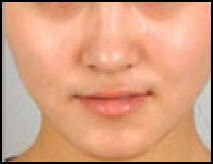
After cosmetic surgery "By definition we are all capable of interbreeding with all other human beings of the opposite sex to produce fertile offspring," wrote James Shreeve in Discover magazine. "In practice, however, people do not mate randomly; they normally choose their partners from within a social group or population immediately at hand and have been doing so for hundreds of generations."
More so than today, people in the past were divided into specific geographical regions by mountain ranges, deserts and oceans. They generally stayed pretty close to their homelands until the beginning of European colonialism in the 16th century, when people from far away regions began mixing and interbreeding. People still seem to prefer their own kind. Studies have shown that people tend to mate with people who resembles themselves in term so things like eye, hair and skin color.
"As a result," Sheeve wrote, "the physical expressions of the genes inherited for an expanding chain of parents and grandparent---most of whom lived in the same region as one another---also tend to cluster, so that there is a great deal of variation from geographical region to another in skin color, hair form, facial morphology, body proportion and a host of immediately less obvious traits."
History of the Concept of Race
Early explorers like Marco Polo traveled by camel or boat over reality short distances each day. "It never occurred to them to categorize people, because they had seen everything in between," University of Michigan anthropologist Loring Brace told Discover magazine. "That changed when you could get into a boat, sail for months, and wind up in a different continent entirely."
The notion of using science to define race can be traced back to Carolus Linnaeus (1707-1778), the Swedish biologist who helped develop the modern system of classifying living things into genus and species. In 1758, Linnaeus took the radical step of establishing “Homo sapiens” as a species within a group of animals called primates and then divided mankind into four races: 1) Europeans, 2) Native Americans, 3) Asians and 4) Africans. He also mentioned tow other categories: “monstous” (hairy creatures with tails described by explorers) and ferus” ("wild boys"). Members of the latter group were occasionally found in the forest and were believed to have been raised by animals (most were actually mentally ill or retarded youngsters abandoned by their parents).
Linnaeus then went a step further and defined four races in terms of personality and dress. He said Native Americans were "red, choleric, upright" and "ruled by habit"; Europeans were "white, sanguine, muscular" and "ruled by custom"; Asians were "pale yellow, melancholy, stiff" and "ruled by belief"; and Africans were "black, phlegmatic, relaxed" and "ruled by caprice." About a century after Linnaeus, Charles Darwin attributed the difference in human races to sexual preference in his second most influential book, “The Descent of Man and Selection in Relation to Sex”.
Problems with the Concept of Race

butt work, before "Race is supposed to be a strictly biological category, equivalent to animal subspecies," Yale anthropologist Jonathan Marks told Discover magazine. "The problem is that humans also use it as a cultural category, and it is difficult if not impossible, to separate those two things from each other."
Racial categories based on skin color and geography often doesn't make any sense. Indians from India, for example, have dark skin (like "blacks") and Europeanlike facial features (like "Caucasians") but they inhabit the continent of Asia (like "Asians").
About 70 percent of cultural anthropologist and half of physical anthropologists have rejected the concept or race as a biological category according to a 1989 Central Michigan University study. Even so, many anthropology textbooks still define five major races: "whites," "African blacks," "Mongoloids," "aboriginal Australians," and "Khoisans." This in turn are divided into various number of sub-races. American Indians fall into the Mongoloid category.
Modern Science, Race and Physical Characteristics
Much of the information that scientists use to study genetics and "race" is ascertained from the analysis of blood types and specific antigens, antibodies and other proteins found in blood. Stanford University population geneticist Luca Cavalili-Sforza, author of “The History and Geography of Human Genes”, has attempted to put together a genetic map of the world by analyzing blood samples taken from different places around the globe.
Cavalli-Sforza's team often had difficulty collecting blood from people in remote places for their study. A farmer in the Central African Republic, for example, brandished an ax when he was asked if it was alright if the scientists took blood samples from his children. He said, "if you take the blood of the children. I'll take yours."
Studies in the United States have shown that many people with mostly European DNA look black and East Asian DNA is common in native Americans.
Diversity Among Peoples
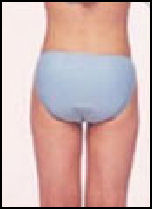
After cosmetic surgery From a genetic perspective, grouping people by skin color or "race" doesn't have a foundation in science. Blacks from the United States, Ghana and Somalia, for example are no more similar to each other that they are to Arabs, Swedes or Greeks.
Many physical traits have nor correlation to skin color or race. Groups with a predominance of "loops" in the fingerprint patterns include most Europeans, black Africans and east Asians, while groups with mostly "whorls" include Mongolian and Australian aborigines. Groups with "arches" include Khoisians and some central Europeans.
Black Americans generally have higher rates of hypertension (high blood pressure) than white Americans but Finns and Russians also have high rates of hypertension while black Africans generally have remarkably low rates of the disease.
Unlike the United States, which has clear difference between whites, blacks and Asians, people in most of the world, says Harvard biologists Orlando make social and class "distinctions based on gradation of color."
Racial Differences and What It Means
In regard to physical differences between groups of people, Cavalili-Sforza has said that once surface traits such as skin color, hair texture, and shape of the nose, eyes and body are discounted, human races are remarkable alike. The differences between individuals within a race are much greater than the difference between races and the diversity among individuals is "so enormous that the whole concept of race becomes meaningless at a genetic level." [Source: Time magazine, January 16, 1995]
In 1972, Harvard biologist Richard Lewontin studied 17 genetic markers in 168 different populations (such as Germans, Thais and Apaches) and concluded "there is more genetic difference within race than there is between that race and another" and "only 6.3 percent of genetic differences could be explained by the individual's belonging to different races."
In 1994, the Human Genome Diversity Project concluded that "genetic variation from one individual to another of the same 'race' swamps the average difference between racial groupings." Hampshire College's Alan Goodman told Newsweek that group people by geographical origin (ethnicity) "is more correct both in a statistical sense and in understanding the history of human variations."
Law enforcement authorities and doctors are some of the few people that can put the concept of race to some positive use. Forensic experts examining murder cases can usually determine whether or not the victim was black, white or Asians based on the measurements of certain bones. Some groups are more likely to get certain diseases than other groups (blacks and sickle cell anemia, for example) and thus doctors can direct preventive measures towards these groups.
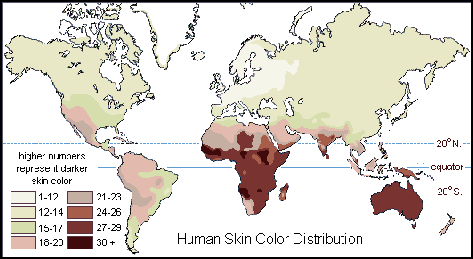
Races Evolving Apart at an Accelerated Pace?
Mark Henderson wrote in Times of London: “Races have evolved away from each other over the past 10,000 years, according to new research that challenges standard ideas about the biological significance of ethnicity. A genetic analysis of human evolution has shown that rather than slowing to a standstill it has speeded up, with different pressures on different populations pushing racial groups further apart. Scientists behind the findings suggest that European, African and Asian populations grew genetically more distinct from each other over several thousand years, as their environments took them down different evolutionary paths. [Source: Mark Henderson, Times of London, December 2007]
”The work indicates that variations tend to differ between races, and that these became more, not less, pronounced. “Human races are evolving away from each other,” said Henry Harpending, Professor of Anthropology at the University of Utah, who led the study. “Genes are evolving fast in Europe, Asia and Africa, but almost all of these are unique to their continent of origin. We are getting less alike, not merging into a single, mixed humanity...The dogma has been these are cultural fluctuations, but almost any temperament trait you look at is under strong genetic influence.”
On the same study the The Dail Mail reported: “Humans are evolving at a faster rate than at any time in history, according to a study. Scientists say the speed of natural selection has accelerated so much that within a few generations we will have evolved resistance to diseases such as diabetes and malaria. Instead of people from different parts of the world becoming more alike over time, they have actually been diverging, the study suggests. The research showed that the population explosion since the Ice Age 10,000 years ago had accelerated the rate of genetic change.
The study was published in the Proceedings of the National Academy of Sciences. One paper on the subject was written by Andrea Migliano and her colleagues at Cambridge University. Another was by Robert Moyzis of the University of California, Irvine, and his colleagues. They found is that about 1,800 protein-coding genes, some 7 percent of the total known, show signs of having been subject to recent natural selection.
There was an implication that if the trend continued separate species could evolve. Scientists however are careful to point out that these changes took place in prehistoric and ancient times. Today, they say, with increased movement of people and increased gene flow that has occurred from intermarrying among ther races the trend has probably been slowed or even reversed.
Image Sources: Wikimedia Commons
Text Sources: New York Times, Washington Post, Los Angeles Times, Times of London, The Guardian, National Geographic, The New Yorker, Time, Newsweek, Reuters, AP, AFP, Wall Street Journal, The Atlantic Monthly, The Economist, Global Viewpoint (Christian Science Monitor), Foreign Policy, Wikipedia, BBC, CNN, NBC News, Fox News and various books and other publications.
Last updated March 2017
